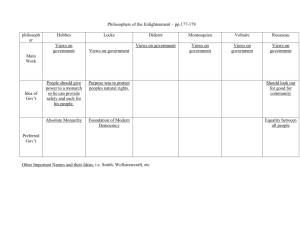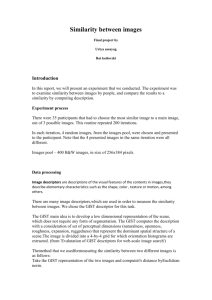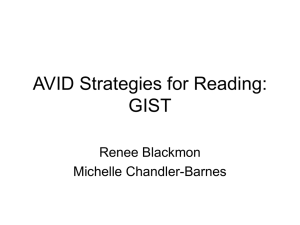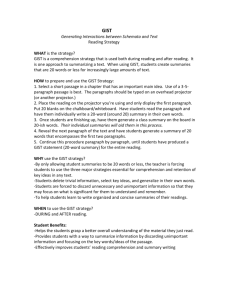Construction & Disto..
advertisement
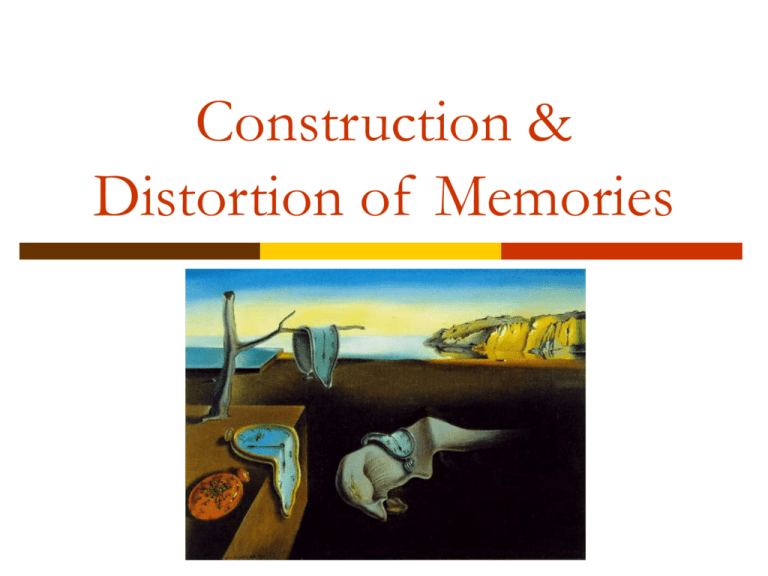
Construction & Distortion of Memories [This page is intentionally left blank.] Memory and Gist Gist ~ theme ~ schema ~ expectation Fuzzily defined, not identical, but clearly related Memory is designed to operate on gist, it can function without gist (as Ebbinghaus showed), but gist is what it does best. We think of memory as a series of processes (encoding, organizing, storing, retrieving, etc.) and gist influences every stage. Memory and Gist Bransford, J.D., & Johnson, M.K. (1973) reasoned that, if memories are the sum of experience and knowledge, then it is possible that a person first comprehends an input and then elaborates on it. If this is true, then people should remember text equally well if relevant knowledge is unavailable. Memory and Gist They told S’s to listen carefully and try to understand a passage, and that they would be asked for immediate recall. They manipulated the availability of the relevant information by showing (or not) the cartoon for 30 seconds prior to hearing the passage. Comprehension ratings were gathered as a manipulation check to determine whether this effected the ability to extract gist. The manipulation worked: those shown the cartoon understood more and remembered more. Memory and Gist Isn’t it possible that people remembered more simply because they had more opportunities to encode the material (with a picture vs. no picture)? A series of replications were run to eliminate other possibilities. A second no context group got to hear the passage twice in a row. An after group was shown the cartoon after having heard the passage. A partial context group was shown a related picture. Memory and Gist Memory and Gist Mean Comprehension Ratings and Mean Number of Ideas Recalled No No Contxt Partial Contxt Contxt1 Contxt2 After Contxt Before Comprehension 2.30 Recall 3.60 3.60 3.80 3.30 3.60 3.70 4.00 6.10 8.00 The mean comprehension ratings and mean number of ideas recalled correlate highly. (r=0.94) Memory and Gist In a subsequent replication an additional factor was added, free recall vs. cued recall. Mean Number of Ideas Recalled (Balloon Passage) No Cue Key Word Cues No Contxt 3.92 4.00 Contxt After 4.33 3.75 Cntxt Before 7.33 8.50 The cues don’t make much difference for the noncomprehending groups, because most of the information just isn’t there to be retrieved. Memory and Gist The moral of the story is that gist drives encoding. Memory and Gist Memory and Gist Brewer & Treyens (1981) created a false “graduate student office”, containing 61 objects designed to vary along two dimensions: more or less noticeable in the room (saliency) more or less likely to exist in a GSO (schema-expectancy). Had two groups of subjects rate the objects in the office (one group for each scale) and 70 additional objects that were not present in the office. Saliency and schema-expectancy correlated -.41 for present objects and -.69 for lures. Memory and Gist S’s were asked to wait in the room for 35 seconds, then taken to a plain room and told about the experiment. S’s were split into three groups that were given different memory tasks: written recall, drawing recall on provided outlines, and recognition. The frequencies with which objects were listed in the recall tasks was tabulated. Correlation between the two recall measures was .94. Memory and Gist Partl Cors b/t Recall Freq & Schema Expectancy & Saliency SE Sal Written Recall Frequency .55 .64 Drawing Recall Frequency .68 .66 Partl Cors b/t Mean Recognition & SE & Sal (recognzd items) SE Sal Present Object Recognition .58 .69 Absent Object Recognition .52 -.36 Memory and Gist Both things that we expect to see and those that, for whatever reason, we are surprised to see (that stand out) tend to get noticed and remembered. This was supported by qualitative analyses. The study demonstrates expectancy congruent and expectancy incongruent encoding. But only things we expect lead to intrusions (expectancy congruent distortion on retrieval). Memory and Gist Some S’s performed both recall and recognition, so Brewer & Treyens created a retrieval ratio by dividing the number who recalled an object by the number that gave it the top recognition rating. This ratio doesn’t correlate significantly with saliency, but partial correlation between retrieval ratio and SE was .56. This shows that the schema (the gist) facilitates retrieval. Similar results found by Hastie & Kumar (1979): inconsistent highest, consistent high, neutral lowest, p.166 in Kunda. Memory and Gist Owens, J., Bower, G. H., & Black, J. B. (1979) had S’s read passage first day and estimated time. P group estimated significantly less reading time, despite having read more. Recalled as much as possible the next day. P group remembers more episodes, more often in the right order, more propositions, but also more intrusions (false alarms). Then cued with titles of episodes for additional recall. C group remembers more and more accurately. Memory and Gist Recall Measures for Prblm and Cntrl Conditions Before & After Cuing Scripts Recalled* Props New Props Total Props Recalled* Intruded** Recalled B/f Cue Problem Control 3.67 2.50 29.24 20.24 15.20 3.76 44.44 24.00 A/f Cue Problem Control 4.56 4.75 38.44 54.63 17.56 8.88 56.00 63.51 Condition * Out of 5 **Out of 190 Memory and Gist Then test for recognition using true propositions, and lures of various types, using 7 point Likert scale ratings. C group more accurate on trues, and P group less accurate on motive relevant lures. Lesson: a theme (or gist) organizes memories and facilitates retrieval. Episodes that lack gist are not necessarily gone, but are disorganized and very difficult to retrieve. Memory and Gist Anderson, R. C., & Pichert, J. W. (1978) wanted to investigate whether storage processes are distinct from retrieval processes. Memory and Gist Created a story about two boys staying home and playing hooky. The story contained information about the house that would be pertinent to a prospective homebuyer or a burglar. The ideas relevant to each were assessed in advance with ratings. S’s were told to read the story from one of the two perspectives. They performed a distracter task for 12 minutes, and were asked to recall as much of the story as they could. S’s then performed a second distracter task, and were asked to recall the story again, but this time from the other perspective. Memory and Gist Proportion of Idea Units Recalled a Function of Perspective 1st/2nd Perspctve Homebuyer/burglar Burglar/homebuyer Burglar ---------------------1st Recl 2nd Recl .51 .68 .61 .36 Homebuyer --------------------1st Recl 2nd Recl .59 .40 .48 .50 What’s important here is that on the second recall S’s remembered more ideas relevant to the new perspective than they had initially. Interviews after the experiment supported this result. Memory and Gist The big idea is that a theme can organize memories and facilitate recall even if introduced after the memory has been encoded (i.e. independently of encoding and storage). Source Amnesia, Source Monitoring and The Hindsight Bias First, an memory test Source Amnesia, Source Monitoring and The Hindsight Bias Well, how did you all do? Any false positives? Kunda (ch 4) discusses that we often mistake the memory for something we imagined for something that actually happened. As imagined events become more rich, we become more likely to mistake them for real events. Source Amnesia, Source Monitoring and The Hindsight Bias Roediger & McDermitt (2000) The words on the list activated their central theme. The central theme is strongly remember, although it was not presented. Was the central theme explicitly or implicitly activated? There are data to suggest it was explicitly activated, what do you think? Source Amnesia, Source Monitoring and The Hindsight Bias Alzheimer’s patients are much worse at recalling words in list, but their false positive rate is the same as healthy adults. Does anyone know other examples of people with memory loss who maintain their ability to encode and retrieve central themes but lose the periphery? Source Amnesia, Source Monitoring and The Hindsight Bias Kunda also discusses stereotype driven inferences as a source of source amnesia. People here that “the lawyer is standing in front of her house.” Later, people report that they remembered hearing about a mansion. Source Amnesia, Source Monitoring and The Hindsight Bias People may confuse where there heard something when the two potential sources are seen as similar to each other, i.e. confusing which of the two female justices. Dimensions that cause us to categorize change depending on our theories of the world. One’s dress only lead to source monitoring problems when that dimension was important, i.e. when deciding if someone should be a media rep. Source Amnesia, Source Monitoring and The Hindsight Bias Hard to reconstruct passed predictions after the event occurs. Monday Morning Quarterbacks. When we retrieve info we reconstruct using current knowledge, cannot escape this. People estimate that others who do not know the result will predict the result because it is obvious. Source Amnesia, Source Monitoring and The Hindsight Bias Mather, Shafir, and Johnson (2000) Relates to Source Monitoring and Hindsight Bias (a little). When remembering past choices, people engage in choice supportive memory distortion. Source Amnesia, Source Monitoring and The Hindsight Bias Choose what roommate you would prefer between two people with positive and negative features. After choice, subjects see list of features and say whether the feature went with roommate A, B, or it’s new. Some of the positive features of B are misattributed to A (fewer negative features are misattributed). Source Amnesia, Source Monitoring and The Hindsight Bias When did misattribution occur? At first encoding causing one choice to seem better causing the choice? When the choice was made to ensure later remembering congruent with a good self image? At the time of source monitoring? Positive new features misattributed to A, at least some happened at final stage. Source Amnesia, Source Monitoring and The Hindsight Bias Why are we designed to err? Flexibility, powerful inductive abilities and maintaining a good self-image has it’s price: maintaining stereotypes, etc. Are you happy with your memory system? Eyewitness Testimony PROS CONS Eyewitness Testimony PROS Ecologically valid research Lowers false conviction rates CONS Eyewitness Testimony PROS CONS Age Person perception Emotional interference Confidence in confidence Source amnesia Misinformation effect Eyewitness Testimony Misinformation Effect Overwriting Interference Eyewitness Testimony PROS Ecologically valid research Lowers false conviction rates CONS Age Person perception Emotional interference Confidence in confidence Source amnesia Misinformation effect Eyewitness Testimony If we suck so bad at it, … should we ditch it?
